Candy PVI 640 N, PVI 630 N, PMI 640 N, PVI 740 N Manual
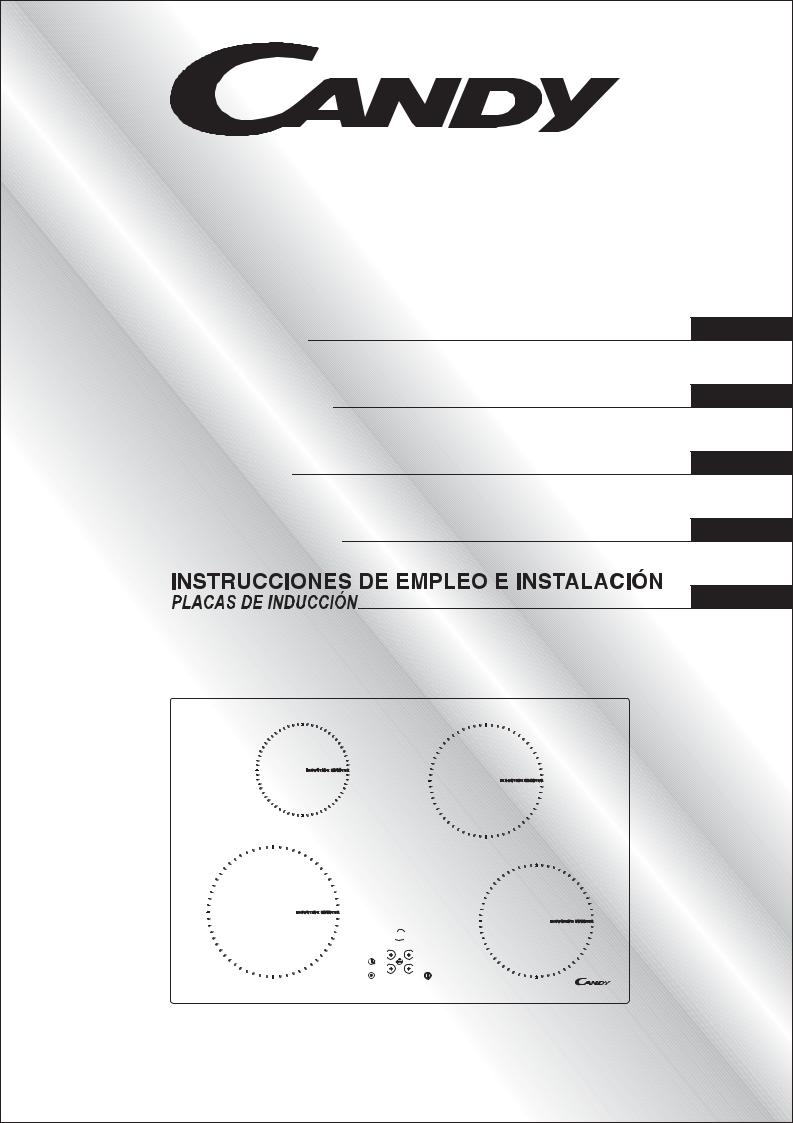
INSTRUCTIONS FOR USE AND INSTALLATION |
GB |
INDUCTION HOBS |
|
NOTICE D'EMPLOI ET D'INSTALLATION |
FR |
TABLE À INDUCTION |
|
INSTALLATIONSUND BEDIENUNGSANLEITUNG |
DE |
CERANFELDER |
|
INSTALLATIEEN GEBRUIKSINDTRUCTIES |
NL |
INDUCTIEKOOKPLAAT |
|
|
ES |
CANDY ELETTRODOMESTICI - Via Privata Eden Fumagalli - 20047 Brugherio Milano Italy |
|

GENERAL WARNINGS
READ THE INSTRUCTIONS BOOKLET CAREFULLY TO MAKE THE MOST OF YOUR HOB.
We recommend you keep the instructions for installation and use for later reference, and before installing the hob, note its serial number below in case you need to get help from the after sales service.
Identification plate
(located under the hob's bottom casing)
|
Made in FRANCE - 232 |
- |
Mod : FE GD21 RB |
220 |
- 240 V |
P. Motors = 30 W
P. Maxi (Oven) - 2350 W
Code: 39354774 -0306 0511
Mod: FE GD21 RB |
|
|
|
Code: 39354774 - 0306 0511 |
Code: 39354774 |
Code: 39354774 |
Code: 39354774 |
220 - 240 V |
- 0306 0511 |
- 0306 0511 |
- 0306 0511 |
|
|
|
|
•It is strongly recommended to keep children away from the cooking zones while they are in operation or when they are switched off, so long as the residual heat indicator is on, in order to prevent the risks of serious burns.
•When cooking with fats or oils, take care always to watch the cooking process as heated fats and oils can catch fire rapidly.
•The hob’s control area is sensitive, do not place hot containers on it.
•Aluminium foil and plastic pans must not be placed on heating zones.
•After every use, some cleaning of the hob is necessary to prevent the build up of dirt and grease. If left, this is recooked when the hob is used and burns giving off smoke and unpleasant smells, not to mention the risks of fire propagation.
•Do not left metallic objects such as knives, forks, spoons or lids on the induction zone,because if they are too large or too heavy, they could become hot
•Never cook food directly on the glass ceramic hob. Always use the appropriate cookware.
•Always place the pan in the centre of the unit that you are cooking on.
•Do not use the surface as a cutting board.
•Do not slide cookware across the hob.
•Do not store heavy items above the hob. If they drop onto the hob, they may cause damage.
•Do not use the hob as a working surface.
•Do not use the hob for storage of any items.
•In the unlikely event of a surface crack appearing, do not use the hob. Immediately disconnect the hob from the electrical power supply and call the After Sales Service.
COOKING HOB |
|
|
|
|
|
|
|
|
|
|
|
|
|
|
|
|
|
|
|
|
|
|
|
||
|
|
|
|
|
|
|
|
|
|
|
||
|
|
|
|
|
|
|
|
|
|
|
|
|
Burners |
|
|
3 INDUCTION |
4 INDUCTION |
2 INDUCTION |
4 INDUCTION |
|
|||||
|
|
|
|
|
|
|
|
2 CERAMIC |
|
|
|
|
|
|
|
|
|
|
|
|
|
|
|||
Supply voltage |
(V/Hz) |
|
|
|
|
|
|
|
|
|||
|
|
|
|
|
|
|
|
|
||||
Installed electric powe (W) |
|
|
|
|
|
|
|
|
||||
|
|
|
|
|
|
|
|
|
||||
Product size (w x d x h) mm. |
|
|
|
|
|
|
|
|
||||
|
|
|
|
|
|
|
|
|
||||
Building-in dimensions (AxB) |
|
|
|
|
|
|
|
|
||||
|
|
|
|
|
|
|
|
|
|
|
|
|
|
|
|
|
|
|
|
|
|
|
|
|
|
|
|
|
|
|
|
|
|
|
|
|
|
|
We are constantly striving to improve product quality and as such may modify appliances to incorporate the latest technical improvements.
Glass Ceramic Hobs conform to directives 73/23/CEE and 89/336/CEE.
1 GB
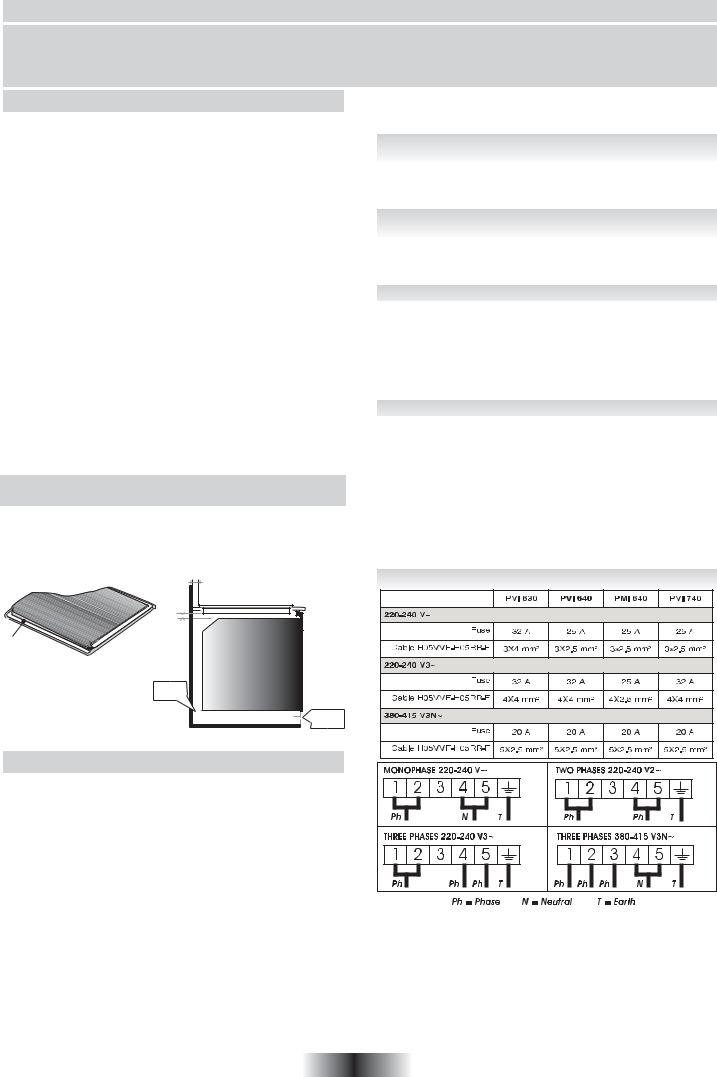
INSTALLATION
Installing a domestic appliance can be a complicated operation which if not carried out correctly, can seriously affect consumer safety. It is for this reason that the task should be undertaken by a professionally qualified person who will carry it out in accordance with the technical regulations in force. In the event that this advice is ignored and the installation is carried out by an unqualified person, the manufacturer declines all responsibility for any technical failure of the product whether or not it results in damage to goods or injury to individuals.
BUILT-IN
The furniture in which your hob will be installed and all adjacent furniture, should be made from materials that can withstand high temperatures. In addition, all decorative laminates should be fixed with heat-resistant glue.
Installation:
• A watertight seal is supplied with the hob.
Before fitting:
-turn the hob upside down, with the glass surface facing downwards.
Make sure the glass is protected.
-fit the seal round the hob.
-make sure that it is correctly fitted to avoid any leakage into the supporting cabinet.
•It is important to fit the hob on a level supporting surface.
•Deformations caused by incorrect fitting can alter the specifications of the worktop and the performance of the hob.
•Leave a gap of at least 5 cm between the appliance and any neighbouring vertical surfaces.
•It is absolutely essential that the recess conforms with the dimensions indicated.
•The height of the flush-mounted part of the hob is 5,5 cm.
•If there is an intermediate division :
-the clearance between the bottom of the casing and an intermediate floor or part of a furniture unit must greater than 2,5 cm so as to allow air circulate.
The minimum distance should be 8 cm.
-furthermore, you should ensure that there is at the rear a ventilation (8 cm) on all the width.
•You can not build the hob in above an oven with no fan, a dishwasher, fridge, freezer or washing machine.
•The body of the hob is fitted which 4 location holes to take the fixing clamps intended to fix the hob in the unit. Place the 4 fixing clamps, before building-in the hob, in such a way that the hob is placed perfectly in the support unit.
The hob is fitted with a power supply cord which allows it to be connected only to a power supply of 220-240 V between phases or between phase and neutral.
•Connect to a socket, to choose the correct fuse, you must refer on the table.
It is however possible to connect the hob to :
. Three phase |
220-240 |
V3~ |
. Three phase |
380-415 |
V3N~ |
To proceed to the new connection, you must adhere the following instructions.
• Before making the connection, make sure that the installation is protected by a suitable fuse, see table, and that it is fitted with wires of a large enough section to supply the appliance normally.
Operations to be carried out on the existing connection :
•Turn over the hob, glass side against the work top, taking care to protect the glass.
•Open the cover.
•remove the screws retaining the terminal block which contains
the shunt bars and the conductors of the supply cord,
•unscrew the cable clamp to release the power supplying cord.
•Pull out the supply cord.
•Operations to be carried out to make a new connection :
-Choose the power supply cable in accordance with the recommendations in the table.
-Pass the power supply cable into the clamp.
-Strip the end of each conductor of the supply cord on a 10 mm length, by taking in account the requested length of the cord for the connection to the terminal block.
-According to the installation and with the help of shunt bars which you should have recovered in the first operation, fix the conductor as shown on the chart.
-Screw the cable clamp and fix the cover.
Note: make sure the terminal board screws are tight.
Hob
Seal
50 mm
25 mm |
mini |
Opening
500 X 50
CONNECTION TO THE TERMINALS ON THE TERMINAL BLOCK:
Opening
500 X 10
ELECTRICAL CONNECTION
"The installation must conform to the standard directives." The manufacturer declines all responsibility for any damage that may be caused by unsuitable or unreasonable use.
Warning :
•Always check before any electrical operation, the supply tension shown on the electricity meter, the adjustment of the circuitbreaker, the continuity of the connection to earth to the installation and that the fuse is suitable.
•The electrical connection to the installation should be made via a socket with a plug with earth, or via an omnipole cut-out switch with an opening gap of at least 3 mm.
If the appliance has a socket outlet, it must be installed so that the socket outlet is accessible.
•The yellow/green wire of the power supply cable must be connected to the earth of both power supply and appliance terminals.
•The manufacturer cannot be held responsible for any accidents resulting from the use of an appliance which is not connected
to earth, or with a faulty earth connection continuity.
•Any queries regarding the power supply cord should be referred to After Sales Service or a qualified technician.
2 GB
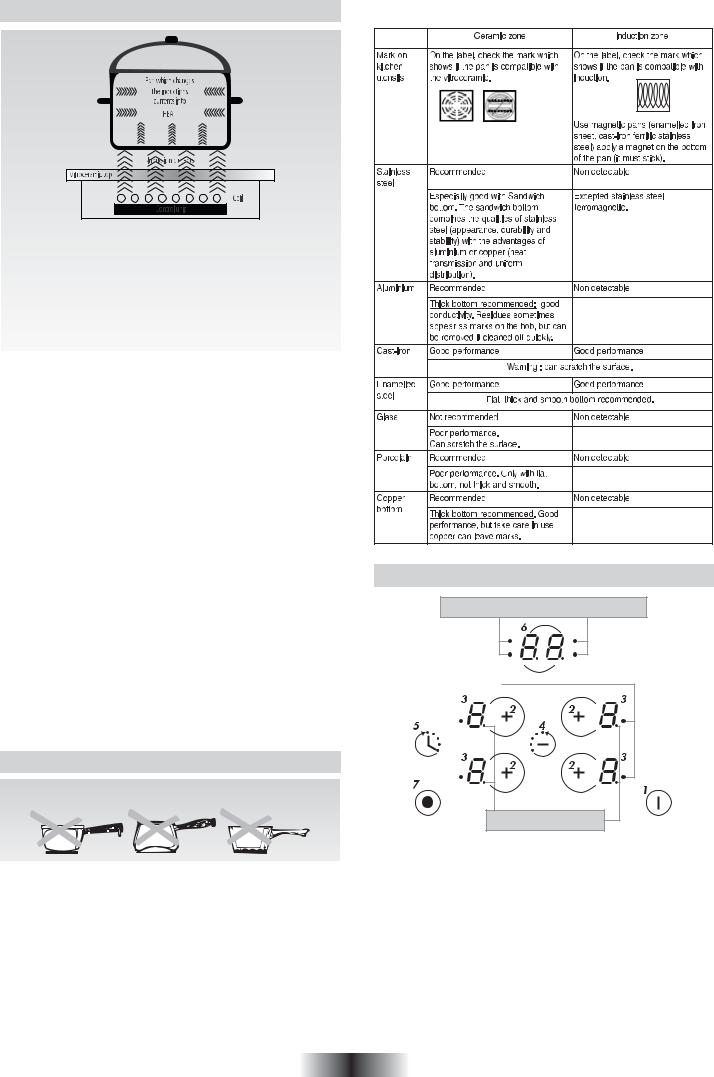
INDUCTION
USE PROCEDURE
An electronic generator powers a coil located inside the appliance.
This coil creates a magnetic field, so that when the pan is placed on the hob, it is permeated by the induction currents.
These currents make the pan into a real heat transmitter, while the glass ceramic hob remains cold.
This system is designed for use with magnetic-bottomed pans
Put simply, induction technology has two main advantages :
-as heat is emitted only by the pan, heat is maintained at its maximum level and cooking takes place without any heat loss.
-There is no thermal inertia, as cooking automatically starts when the pan is placed on the hob and stops when it is removed.
A HIGH SAFETY APPLIANCE ....
If your hob is correctly installed and used, the safety devices will rarely be needed.
•Ventilation fan : to protect and cool the supply and control components. It has two speeds, operating automatically. The fan works even if the plates are off and this till the electronic system has enough cooled down.
•Safety "Transistor" : a probe checks permanently the temperature of the electronic components. If the heat is increasing excessively, it automatically decreases the power of the plates then cuts them down (the display for power level is flashing) as far as the temperature of the components meets with the standard again, the hob starts working.
•Safety "Empty pan" : a probe is placed under each heating area. It will immediately detect a wrong temperature for the empty pan, or the glass ceramic.
•Safety "Detection" : the presence detector allows the working and so the heating. A small object (eg a spoon, knife or ring) placed on the heating area will not be considered as a pan and therefore the hob will not come on.
•Safety "Boiling over and splashing : if any boiling over and splashing occur, the hob will stop. If a big spill or object covers at least two buttons, for at least 10 seconds, clean up the spill or remove the object, the hob is not operating.
HOB COOKWARE ADVICE
Using good quality cookware is critical for setting the best performance from your hob.
•Always use good quality cookware with perfectly flat and thick bases : using this type of cookware will prevent hot spots that cause food to stick. Thick metal pots and pans will provide an even distribution of heat.
•Ensure that the base of the pot or pan is dry : when filling pans with liquid or using one that has been stored in the refrigerator, ensure that the base of the pan is completely dry before placing it on the hob. This will help to avoid staining the hob.
•Use pans whose diameter is wide enough to completely cover the surface unit : the size of the pan should be no smaller than the heating area. If it is slightly wider the energy will be used at its maximum efficiency.
The following information will help you select the pans best adapted to obtain good results.
HOW TO OPERATE THE HOB
Cooking zone programming indicator
Control Led
1 - HOB ON / OFF BUTTON
2 - COOKING ZONE SELECTION BUTTON AND “+” BUTTON
3 - INFORMATION DISPLAY
4 - “-” BUTTON
5 - “TIMER” SELECTION
6 - “TIMER” DISPLAY
7 - “BOOSTER” BUTTON (INDUCTION MODELS)
3 GB
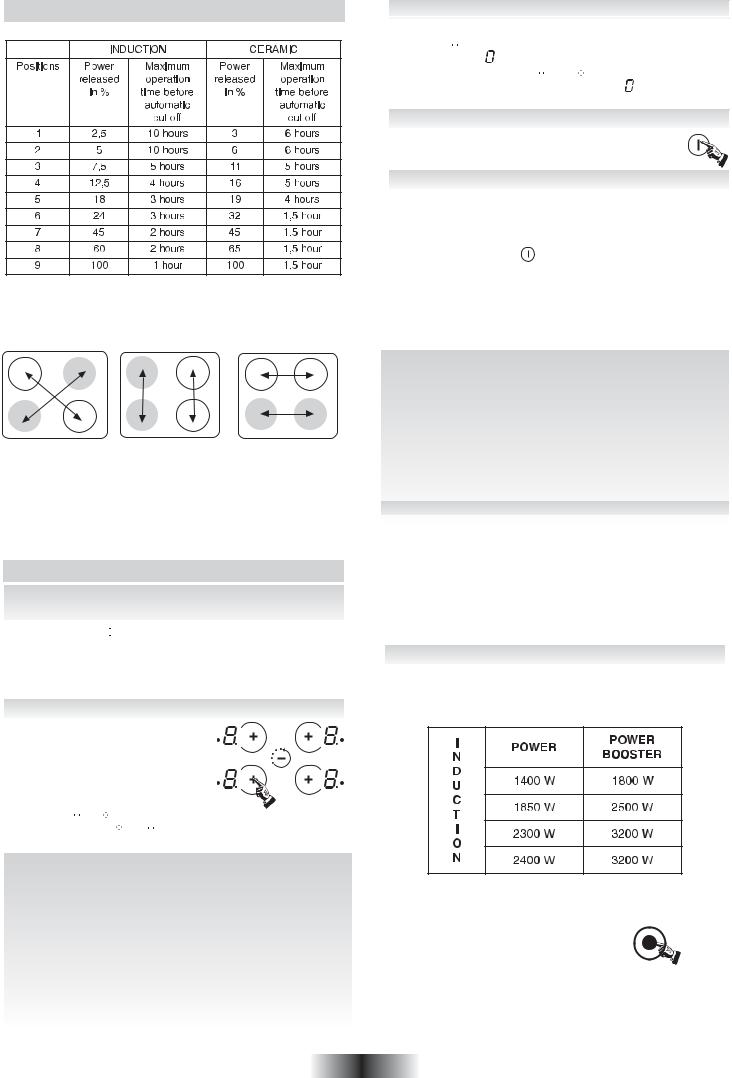
THE DIFFERENT POSITION
The different positions correspond to the following power ratings :
For increased safety, the cooking zones cut off automatically if they are left on too long. The cut off depends on the heat level used.
NOTE: The induction hob works with a generator wich supplies simultaneously 2 plates per area, according to model:
Each area take in charge a maximum power of 3700 W. Consequently, in the same area, when the Booster function is on and the second plate has reached a power level of 9 or 8 the latest is automatically decreased to the level 7 and this decrease is shown by a flashing display for information.
Warning : the Booster works during 10 minutes, after this time, it stops and the plate starts heating again at the setting 9, the power of the generator being decreased, the power level of the second plate comes back to its previous setting.
THE USE
•After powering up the hob, wait 8 seconds to activate the electronic controls.
-Press the button  , for 3 seconds.
, for 3 seconds.
Electronic control of the hob is activated. In each display zone the heat level  is displayed and the control LED blinks.
is displayed and the control LED blinks.
-After 10 seconds whithout use, the electronic control goes off and the starting operation has to be repeated.
•STARTING A COOKING ZONE
- Press the selection button of the required cooking zone. In the display zone, the control LED is on steady. It shows that the zone is live.
-Press the  or
or button to select a heat level between 1 and 9. Hold down the
button to select a heat level between 1 and 9. Hold down the  or
or  button and the heat level increases or decreases gradually.
button and the heat level increases or decreases gradually.
The following examples are for information only. Personal experience should then let you adapt these settings to your taste and habits.
0 |
: |
Off |
1 |
: |
) |
2: ) ..... Melting heat
3: Keeping hot
4: Heating up
5: Thawing, stewing, full cooking, low temperature cooking
6: Cooking without lid
7: Frying, meat browning and roasting
8: High temperature cooking and roasting, seizing
9: Frying
Booster : Boiling large quantities of liquids...
• STOPPING A COOKING ZONE
-Press the selection button of the required cooking zone.
-Press the  button to display heat level
button to display heat level  . Now the zone goes
. Now the zone goes
off, the indicator goes off after 10 seconds.
- To stop rapidly, press the  and
and  buttons at the same time. The heat level automatically goes down to .
buttons at the same time. The heat level automatically goes down to .
The cooking zone goes off.
• GENERAL STOP
The cooking zones and the timer can be stopped at any moment by pressing for 3 seconds on the On-Off button.
• FAST HEATER OPERATION
All zones are fitted with a "Fast heater" which allows to get a faster temperature increase of the heating areas. Ideal to seal meat or to bring quickly to the boil large quantitites of liquids.
Starting the fast heater
-Press the on/off button .
-Start the required zone, press the " + " button to obtain position “9”, release the button briefly and press again the " + " button ; the display alternates showing "A" “fast heater” and "9" heat level.
-If necessary reduce to the required heat position, the display alternates showing "A" “fast heater” and the new heat position.
Cooking |
|
Power |
|
Time of |
|
Maximum |
position |
|
released |
|
fast heater |
|
operating |
|
|
(%) |
|
(minutes) |
time before |
|
|
|
|
|
|
|
automatic |
|
|
|
|
|
|
cut off* |
0 |
: |
0 % |
: |
0 |
: |
0 H |
1 |
: |
3 % |
: |
1 |
: |
6 H |
2 |
: |
6 % |
: |
3 |
: |
6 H |
3 |
: |
11 % |
: |
5 |
: |
5 H |
4 |
: |
16 % |
: |
6,5 |
: |
5 H |
5 |
: |
19 % |
: |
8,5 |
: |
4 H |
6 |
: |
32 % |
: |
2,5 |
: |
1,5 H |
7 |
: |
45 % |
: |
3,5 |
: |
1,5 H |
8 |
: |
65 % |
: |
4,5 |
: |
1,5 H |
9 |
: |
100 % |
: |
0 |
: |
1,5 H |
E.g. 1800 W zone at position 6 = 32% of 1800 W power released
When the “Fast heater” is on, the zone supplies 1800 W power for 2.5 minutes, and adjusts to 576 W after this time.
. When the "Fast heater" is done, the display of the power level remains steady.
• ACTIVATION OF THE BOOSTER FUNCTION (induction models)
The booster function allows to get by a simple pressure the cooking zone working with a power of 2200 W or 3000 W according to the zone, for 10 minutes period. Ideal to bring to the boil large quantities of liquids ...
Activation of the BOOSTER function :
-Press the setting key of the cooking zone fitted with the booster function.
The control led is displayed.
- Press the key to start the Booster. The Booster is active for 10 minutes.
The P mark (power) appears.
When the time is over, the power level decreases to 9.
A pressure on the key "-" cancels the booster function, and the power level decreases
4 GB
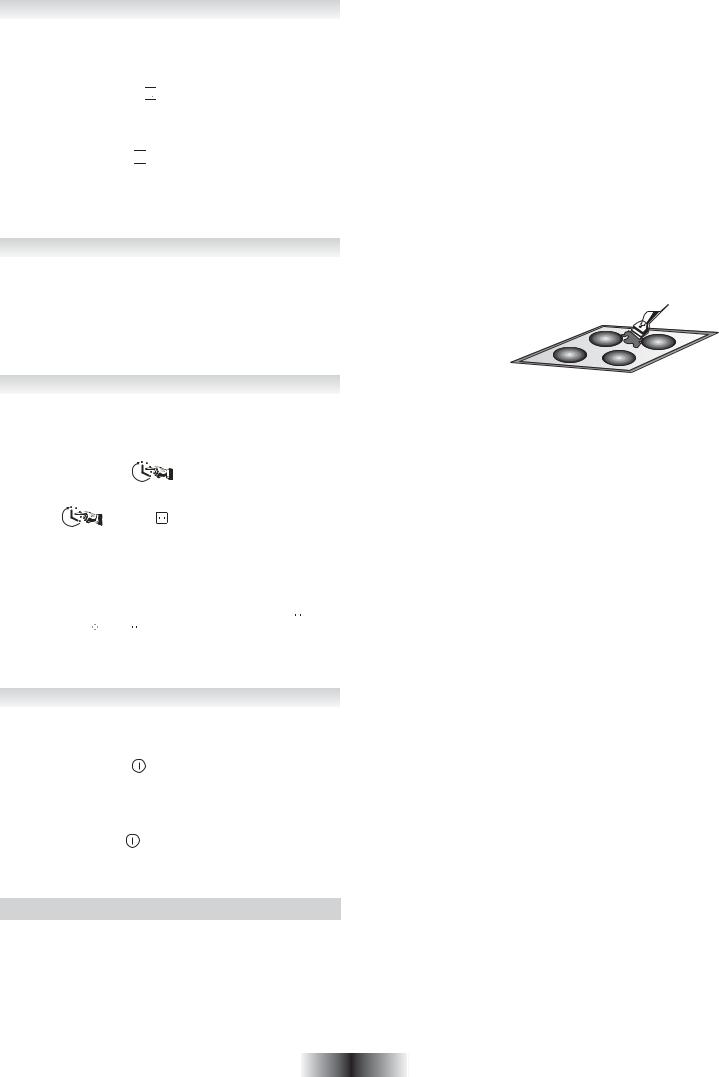
• PAN DETECTOR (induction models)
When the hob is operating, the pan detector provides the advantage of automatically stopping or starting the heat of the cooking zone in contact with or on removal of the pan.
If therefore offers energy savings.
If the cooking zone is used with a suitable pan* : the display shows the heat level or 


 when the booster is operating.
when the booster is operating.
* The induction needs pans compatibles so fitted with magneticbottomed, see table page 9 and pans big enough to fully cover the zone.
If the cooking zone is used without a pan or with an unsuitable pan : the display shows 


 . The zone does not start. If no pan is detected after 10 minutes, the starting operation is cancelled.
. The zone does not start. If no pan is detected after 10 minutes, the starting operation is cancelled.
IMPORTANT:
To stop the cooking zone, you must stop the hob normally, you cannot just remove the pan. The pan detector does not work as the hob on/off button.
• RESIDUAL HEAT INDICATOR
The control panel tells the user when the surface temperature of the cooking zones exceeds about 60°C, by the following displaying:  . When the temperature goes back below 60°C, the
. When the temperature goes back below 60°C, the  display goes off.
display goes off.
For ending the cooking, we advise switching off the cooking zone and using the residual heat of the zone to finish cooking gently.
N.B. After a cut in the current, the residual heat indicator disappears completely, even if the surface temperature exceeds 60°C.
• PROGRAMMING A COOKING ZONE
Every cooking zone can be programmed for a maximum time of 99 minutes. Only one zone, at a time, can be programmed.
-Start the required zone by following the previous instructions. The control LED near the heat level must be displayed, it shows
that the zone is live.
- Press the Timer button.
The zone mark around the timer display shows the controlled zone.
- Press the |
button or |
|
to select the time in minutes. |
|
This is saved automatically after three seconds.
 The programmed time can be modified at any moment by pressing the timer selection button, the timer control LED must be on. When the time has run, the cooking zone goes off automatically and an audible beep sounds for 1 minute. Press any button to stop it.
The programmed time can be modified at any moment by pressing the timer selection button, the timer control LED must be on. When the time has run, the cooking zone goes off automatically and an audible beep sounds for 1 minute. Press any button to stop it.
 The programmed time can be reset to
The programmed time can be reset to  using the
using the  button or pressing the
button or pressing the  and
and  buttons at the same time, the cooking zone is then no longer linked to the timer but stays operational. So you will have to stop the zone independently.
buttons at the same time, the cooking zone is then no longer linked to the timer but stays operational. So you will have to stop the zone independently.
 The timer can be used alone as a reminder, it will ring at the end of the programmed time.
The timer can be used alone as a reminder, it will ring at the end of the programmed time.
• LOCKING BUTTON OPERATION
The locking function prevents anyone from starting the hob. It is also used for cleaning the control strip as the controls can be locked without the hob being on.
To lock the hob :
- Press the on/off button .
- Press simultaneously " - " button and " + " button of the front right zone, and then press again on the " + " button of this zone. The hob is locked, the locking indicator " L " is displayed on all zones for 20 seconds.
To unlock the hob :
- Press the on/off button . The locking indicator " L " is displayed on all zones.
-Press simultaneously the " - " button and the " + " button of the front right zone, and then press again on the " - " button of this zone. The hob is unlocked.
CLEANING AND MAINTENANCE
•Before carrying out any maintenance work on the hob, allow it to cool down.
•Only products, (creams and scrapers) specifically designed for glass ceramic surfaces should be used. They are obtainable from hardware stores.
•Avoid spillages, as anything which falls on to the hob surface
will quickly burn and will make cleaning more difficult.
•It is advisable to keep away from the hob all substances which are liable to melt, such as plastic items, sugar, or sugar-based products.
MAINTENANCE:
-Place a few drops of the specialised cleaning product on the hob surface.
-Rub any stubborn stains with a soft cloth or with slightly damp kitchen paper.
-Wipe with a soft cloth or dry kitchen paper until the surface is clean.
If there are still some stubborn stains:
-Place a few more drops of specialised cleaning fluid on the surface.
-Scrape with a scraper, holding it at an angle of 30° to the hob, until the stains disappear.
-Wipe with a soft cloth or dry kitchen paper until the surface is clean.
-Repeat the operation if necessary.
A FEW HINTS:
Frequent cleaning leaves a protective layer which is essential to prevent scratches and wear. Make sure that the surface is clean before using the hob again. To remove marks left by water, use a few drops of white vinegar or lemon juice. Then wipe with absorbent paper and a few drops of specialised cleaning fluid. The glass ceramic surface will withstand scraping from flatbottomed cooking vessels, however, it is always better to lift them when moving them from one zone to another.
 30° Maxi
30° Maxi
NB:
Do not use a sponge which is too wet. Never use a knife or a screwdriver.
A scraper with a razor blade will not damage the surface, as long as it is kept at an angle of 30°.
Never leave a scraper with a razor blade within the reach of children.
Never use abrasive products or scouring powders.
5 GB

AFTERCARE
Before calling out a Service Engineer please check the following:
— that the plug is correctly inserted and fused; If the fault cannot be identified:
switch off the appliance — do not tamper with it — call the Aftercare Service Centre. The appliance is supplied with a guarantee certificate that ensures that it will be repaired free of charge at the Service Centre.
PROBLEM SOLVING
The induction hob gives shorings out.
• Normal. The cooking fan of the electronic components is on.
The induction hob gives a light whistling out.
•Normal. According to the working frequency of the inductors, a light whistling can occur when using several cooking zones on maximum power.
Cooking zones that do not maintain a rolling boil or a fast enough frying rate.
•You must use pans which are absolutely flat. If light is visual between the pan base and a straight edge, the surface unit will not transfer heat properly.
•Pan bottoms should closely match the diameter of the heat zone selected.
Foods cook slowly.
•Improper cookware being used. Pan bases should be flat, fairly heavy-weight and the same diameter as the heat zone selected.
Tiny scratches (may appear as cracks or abrasions) on the glass surface of the hob.
•Incorrect cleaning methods, cookware with rough bases, or coarse particles (salt or sand) trapped between the cookware and the surface of the hob.
Use recommended cleaning procedures, be sure cookware bases are clean before use and use cookware with smooth bases.
Metal markings (may appear as scratches).
•Do not slide aluminium cookware across the surface. Use recommended cleaning procedure to remove marks.
•Incorrect cleaning materials have been used, spillage or grease stains remain on the surface, use a razor scraper and recommended cleaning product.
Dark streaks or specks.
• Use a razor scraper and recommended cleaning product.
Areas of discoloration on cooktop.
•Marks from aluminium and copper pans as well as mineral deposits from water or food can be removed with the cleaning cream.
Hot sugar mixtures / plastic melted to the surface.
• See the Glass Hob Cleaning section.
The hob is out of order, or some heat zones do not work.
•The shunt bars are not properly fitted on the terminal block. Check the connection is made in conformity with the instructions page 2.
The hob does not operate.
• A big spill or object covers at least two buttons, for at least 10 seconds. Clean up the spill or remove the object.
• The control panel is locked. Press the “Locking” button to release.
The hob does not cut off
•The control panel is locked. Press the “Locking” button to release. Refer to the section, page 5.
The hob stops automatically
•A spill covers at least two buttons for more than 10 seconds; the hob switches to safety, and an audible beep sounds so long as the buttons are covered. Clean up the spill or remove the object.
•The cooking zones stop automatically if they are left on for too long. Refer to the section, page 4.
Frequency of on/off operations for cooking zones
•The on-off cycles vary according to the required heat level: - low level: short operating time,
- high level: long operating time.
“H” display, residual heat indicator, blinking
•The electronic temperature is too high. A technician should verify the fitting in compliance with the recommendations, page 2.
This appliance is marked according to the European
directive 2002/96/EC on Waste Electrical and Electronic Equipment (WEEE). By ensuring this product is disposed of correctly, you will help prevent potential negative consequences for the environment and human health, which could otherwise be caused by
inappropriate waste handling of this product.The symbol on the product indicates that this product may not be treated as household waste. Instead it shall be handed over to the applicable collection point for the recycling of electrical and electronic equipment Disposal must be carried out in accordance with local environmental regulations for waste disposal.For more detailed information about treatment, recovery and recycling of this product, please contact your local city office, your household waste disposal
service or the shop where you purchased the product.
6 GB

INSTRUCTIONS GENERALES
LIRE ATTENTIVEMENT LA NOTICE POUR VOUS PERMETTRE DE TIRER LE MEILLEUR PARTI DE VOTRE APPAREIL. Nous vous conseillons de conserver la notice d'installation et d'utilisation pour toute consultation ultérieure, et de noter ci-dessous, avant installation de la table, le numéro de série de l'appareil en cas d'éventuelle demande d'intervention du service après-vente.
Plaque signalétique
(située sous le caisson inférieur de la table)
|
Made in FRANCE - 232 |
- |
Mod : FE GD21 RB |
220 |
- 240 V |
P. Motors = 30 W
P. Maxi (Oven) - 2350 W
Code: 39354774 -0306 0511
Mod: FE GD21 RB |
|
|
|
Code: 39354774 - 0306 0511 |
Code: 39354774 |
Code: 39354774 |
Code: 39354774 |
220 - 240 V |
- 0306 0511 |
- 0306 0511 |
- 0306 0511 |
|
|
|
|
•Pendant son fonctionnement ou dans le cas de l'extinction d'un foyer, tant que l'indicateur de chaleur résiduelle est allumé, il est vivement conseillé de tenir les enfants à l'écart de la plaque afin d'éviter les risques de brûlure grave.
•Lorsque vous cuisinez avec des graisses ou de l'huile, prenez garde de toujours surveiller le déroulement de la cuisson car les graisses ou l'huile surchauffées peuvent s'enflammer rapidement.
•La plage de commande de la table est sensible, ne pas placer dessus des récipients chauds.
• Les feuilles d'aluminium et les récipients en matière plastique ne doivent pas être placés sur les surfaces chaudes.
•Après chaque utilisation, un petit nettoyage de la table est nécessaire, pour éviter l'accumulation des salissures et des graisses. Cellesci recuiraient à chaque nouvel usage et se carboniseraient en dégageant une fumée et des odeurs désagréables, sans compter les risques de propagation d'incendie.
•Ne pas déposer d’objets métalliques tels que couteaux, fourchettes, cuillères ou couvercle sur la table car si leur dimension ou leur masse métallique est suffisamment importante, ils peuvent s’échauffer et endommager la table.
•Ne jamais cuisiner directement sur la table, employer des récipients.
•Placer toujours la casserole bien centrée sur le foyer utilisé.
•Ne pas utiliser la surface de la table comme planche à découper, ou plan de travail.
•Ne pas faire glisser les casseroles sur la table : risque de rayures.
•Ne pas stocker d'objets lourds au dessus de la table, ils pourraient tomber et endommager la table.
•Ne pas entreposer sur la table des objets quels qu'ils soient.
•Dans le cas improbable où une fêlure apparaîtrait sur le verre, déconnecter immédiatement l'appareil de l'alimentation et adressezvous directement au Service après-vente.
Toutes ces caractéristiques sont données à titre indicatif. Soucieux de toujours améliorer la qualité de sa production, le constructeur pourra apporter à ses appareils des modifications liées à l'évolution technique en respectant les conditions fixées à l'article R 132-2 du Code de la Consommation.
Appareils conformes aux directives CEE 89/336, 73/23.
7 FR

INSTALLATION
La mise en place fonctionnelle des appareils ménagers dans leur environnement est une opération délicate qui, si elle n'est pas correctement effectuée, peut avoir de graves conséquences sur la sécurité des consommateurs. Dans ces conditions, il est impératif de confier cette tâche à un professionnel qui la réalisera conformément aux normes techniques en vigueur. Si malgré cette recommandation, le consommateur réalisait lui-même l'installation, le constructeur déclinerait toute responsabilité en cas de défaillance technique du produit entraînant ou non des dommages aux biens et/ou aux personnes.
ENCASTREMENT
Le meuble ou le support dans lequel doit être encastrée la table, ainsi que les parois du meuble qui pourraient juxtaposer celui-ci, doivent être d'une matière résistant à une température élevée. De plus, il est nécessaire que le revêtement qui recouvre le meuble ou le support soit fixé par une colle résistant à la chaleur afin d'éviter le décollement.
Installation:
•Un joint d'étanchéité est livré avec la table de cuisson.
Avant encastrement:
•retourner la table face verre vers le bas, en prenant soin de protéger le verre.
•Placer le joint tout autour de la table.
•Veiller particulièrement à le placer correctement afin d’éviter toute infiltration dans le meuble support.
•S’assurer que la surface sur laquelle va reposer la table soit parfaitement plane.
•Les déformations éventuelles provoquées par une mauvaise pose de la table risquent d’entraver les performances de l’appareil.
•Prévoir un espace de 5 cm minimum entre l’appareil et les parois verticales avoisinantes.
•La découpe du meuble pour encastrer la table à induction doit impérativement être conforme aux cotes indiquées sur le dessin.
•La hauteur de la partie encastrée de la table est de 5,5 cm.
•S’il existe une cloison intermédiaire :
-s’assurer que la distance qui sépare le dessous de l’appareil et la cloison intermédiaire soit supérieure à 2,5 cm pour laisser l’air circuler. Donc, par rapport au plan de travail, la distance minimale doit être de 8 cm.
-prévoir à l’arrière de la cloison un passage d’air de 8 cm.
• L’encastrement de la table de cuisson au dessus d’un four non ventilé, lave-vaisselle, réfrigérateur, congélateur ou lave-linge n’est pas possible.
• Le caisson est équipé de 4 emplacements prévus pour recevoir les pattes de fixation destinées à l’immobilisation de la table sur le meuble. Les placer, avant encastrement, de manière à ce que la table soit parfaitement plaquée au meuble support.
TABLE
50 mm
Joint
25 mm |
mini |
Ouverture
500 X 50
Ouverture
500 X 10
• Le fil de protection vert/jaune doit être relié aux bornes de terre, de l’appareil d’une part, et de l’installation d’autre part.
•Notre responsabilité ne saurait être engagée pour tout incident ou ses conséquences éventuelles qui pourraient survenir lors de l’usage d’un appareil non relié à la terre, ou relié à une terre dont la continuité serait défectueuse.
•Toute intervention se rapportant au câble d’alimentation doit impérativement être réalisée par le Service après-vente ou une personne de qualification similaire.
La table est livrée avec un câble d’alimentation permettant le raccordement exclusivement sous une tension de 220-240 V entres phases ou entre phase et neutre.
• Raccorder à une prise, pour le choix du fusible, se reférer au tableau ci-dessous.
Il est toutefois possible de raccorder la table en :
Monophasé 220-240V2~, Triphasé 220-240V3~ ou Triphasé 380-415V3N~.
Pour procéder au nouveau raccordement, il est impératif de respecter les consignes citées ci-dessous.
• Tout d’abord vérifier que l’installation est protégée par un fusible approprié, voir tableau, et que l’installation comporte des fils d’une section suffisante pour alimenter normalement l’appareil.
1- Opérations à effectuer sur le raccordement existant :
-retourner la table, face verre contre le plan de travail, en prenant soin de protéger le verre.
-Ouvrir le capot.
-Libérer le câble d’alimentation :
. dévisser les vis de la plaque à bornes qui maintiennent les
barrettes shunts et les fils conducteurs du câble d’alimentation.
. Dévisser le serre-câble pour retirer le câble d’alimentation.
. Le retirer.
2- Opérations à effectuer pour réaliser le nouveau raccordement :
-choisir le câble d’alimentation en fonction des recommandations du tableau.
-Passer le câble d’alimentation dans le serre-câble.
-Dénuder l’extrémité de chaque conducteur du câble d’alimentation sur une longueur de 10 mm, en tenant compte de la longueur nécessaire du câble d’alimentation pour le raccordement à la plaque à bornes.
-Comme indiqué sur le tableau, positionner les barrettes shunts, récupérées lors de la première opération, en respectant les marquages sur la plaque à bornes.
-Revisser le serre-câble et refermer le capot.
RACCORDEMENT SUR LA PLAQUE A BORNES :
LE RACCORDEMENT ELECTRIQUE
"L’installation recevant l’appareil cité en référence doit être conforme à la norme en vigueur dans le pays d’installation.”
Le constructeur décline toute responsabilité en cas de non respect de cette disposition.
Attention :
•Avant de procéder au raccordement, le technicien doit vérifier la tension d'alimentation indiquée au compteur, le réglage du disjoncteur, le calibre du fusible et la continuité de la terre de l'installation.
•Le raccordement électrique au réseau doit être effectué par une prise de courant avec prise de terre, ou par l'intermédiaire d'un dispositif à coupure omnipolaire ayant une distance d'ouverture des contacts d'au moins 3 mm.
Si l'appareil comporte une prise de courant, il doit être installé de telle façon que la prise de courant soit accessible.
8 FR

INDUCTION
Récipient qui transforme
le flux d’induction en chaleur
Flux d’induction
Dessus vitrocéramique
Bobine |
Module commande/contrôle |
PRINCIPE DE FONCTIONNEMENT
Un module électronique alimente et commande électriquement une bobine située à l’intérieur de l’appareil.
Cette bobine créé un champ magnétique de telle sorte que le récipient posé sur le support se trouve traversé par des courants dits “d’induction”.
Ces derniers transforment le récipient en véritable émetteur de chaleur, le dessus vitrocéramique restant froid.
Ce procédé implique l’utilisation de récipients magnétiques.
Concrètement, la technologie de l’induction conduit à deux résultats fondamentaux :
-la chaleur n’étant émise que par le récipient, la puissance de chauffe restituée est maximale et la cuisson s’effectue sans déperdition calorifique.
-il n’y a pas d’inertie thermique puisque la pose ou le retrait du récipient sur le support déclenche instantanément le démarrage ou l’arrêt de cuisson.
UN APPAREIL DE HAUTE SECURITE ....
Si votre table est installée et utilisée dans de bonnes conditions, ces sécurités ne fonctionneront que très rarement.
•Turbine de ventilation : pour protéger et refroidir les organes de commande et d’alimentation. La turbine est à deux vitesses, elles agissent automatiquement. La turbine fonctionne même si les foyers sont à l’arrêt et ce tant que l’électronique n’est pas suffisamment refroidie.
•Sécurité "Transistor" : une sonde surveille en permanence la température des composants électroniques. Si cette dernière est excessive, elle réduit automatiquement la puissance des foyers puis coupe leur fonctionnement (l’affichage du niveau de puissance clignote). Lorsque la température des composants redevient conforme, la table fonctionne à nouveau.
•Sécurité "Casserole vide" : une sonde placée sous chaque zone de chauffe détecte la température anormale d’un récipient vide et du verre vitrocéramique.
•Sécurité "Détection" : le détecteur de présence autorise le fonctionnement, donc la chauffe. Un récipient non adapté ou un objet de petite dimension (cuillère à café, couteau ...) posé sur la zone de chauffe ne sera pas considéré comme récipient donc la chauffe ne se réalisera pas.
•Sécurité "Débordement et projection” : des protections sont prévues pour arrêter le fonctionnement de la table lors d’un éventuel débordement ou de grosses projections. Si un gros débordement ou objet recouvre au moins deux touches, pendant 10 secondes au minimum, la table arrête son fonctionnement.
LE CHOIX DES USTENSILES
L’utilisation de récipients de qualité est nécessaire pour obtenir de bons résultats de cuisson.
•Utiliser des récipients de bonne qualité à fond plat et épais: le fond rigoureusement plat supprimera les points de surchauffe sur lesquels les aliments attachent, et l’épaisseur du métal permettra une parfaite répartition de la chaleur.
•Veiller à ce que le fond des récipients soit sec: lors du remplissage du récipient ou lorsqu’on utilise une casserole sortant du réfrigérateur, par exemple, s’assurer que l’ustensile est bien sec, cette précaution évitera toute salissure sur le plan de cuisson.
• Utiliser des récipients d’un diamètre suffisant pour recouvrir entièrement le foyer : il convient de veiller à ce que le fond soit au moins aussi grand que la zone de cuisson. Si le fond est légèrement plus grand, l’énergie est utilisée de manière optimale.
Les informations suivantes vous aideront à choisir les récipients les mieux adaptés pour obtenir de bons résultats.
PRESENTATION DU TABLEAU DE BORD
REPERE DE PROGRAMMATION FOYER
6
|
3 |
2 |
|
|
2 |
|
|
5 |
4 |
3 |
|
|
|
||
|
2 |
2 |
|
7 |
3 |
3 |
1 |
|
|
|
|
|
DIODE DE COMMANDE |
|
|
1 - TOUCHE MARCHE/ARRÊT
2 - TOUCHE DE SELECTION DU FOYER DE CUISSON ET TOUCHE “ + ”
3 - AFFICHAGE DU DISPLAY
4 - TOUCHE “ - ”
5 - TOUCHE “MINUTEUR”
6 - “AFFICHAGE DU MINUTEUR”
7 - TOUCHE “BOOSTER” (modèle induction)
9 FR
